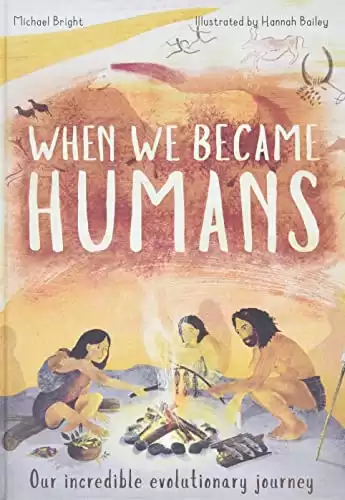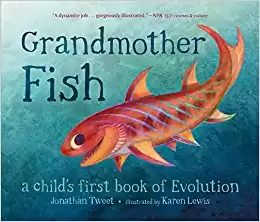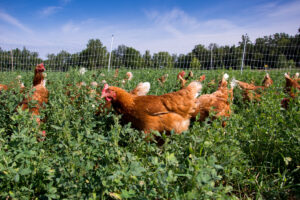Evolution has recently been the subject of many great children’s books. That’s because evolution theory can be a complex topic for children to understand. But the importance of teaching young readers about science and demystifying their natural world has seen a growing interest in children’s books about evolution.
Many children’s books have been written on the subject, which can help make it easier for young minds to grasp. These books are both educational and entertaining to keep readers’ attention. Moreover, they will capture your child’s imagination and help them learn about this important topic.
Let’s explore the best children’s books about evolution.
 Check Amazon
Check Amazon- 48 pages.
- Customers recommend this book for children ages 3 through 5.
- A narrative with engaging illustrations.
- A clear, straightforward presentation of the concept of evolution.
- Illustrated through timelines.
 Check Amazon
Check Amazon- 47 pages.
- Recommended for readers ages 8 through 12.
- Author shows a keen awareness of the audience.
- Illustrations to capture the imagination.
 Check Amazon
Check Amazon- 160 pages.
- Recommended for readers ages 9 and older.
- Backed by science to grab young readers' attention.
- Includes activities to do along with reading.
 Check Amazon
Check Amazon- 48 pages.
- Recommended for children ages 6 through 10.
- Full of fun to keep the interest of readers.
- Paints a clear picture of the mystery of evolution and its complexities due to human intervention.
 Check Amazon
Check Amazon- 48 pages.
- Recommended for children ages 5 through 8.
- Covers the concept of interconnectedness.
- Brings the notion of evolution down to the reader's level.
 Check Amazon
Check Amazon- 64 pages
- Recommended for children ages 7 through 11
- Details key aspects of the early human story
- A well-researched and thought-provoking book
- Explains complex concepts in a way that is accessible to a lay audience
 Check Amazon
Check Amazon- 40 pages
- Customers recommend this book for children ages 2 through 5
- Great treatment of evolution for young readers
- Full of illustrations
- Helpful science notes for parents (to help answer those inconvenient questions)
 Check Amazon
Check Amazon- 40 pages
- Customers recommend this book for children ages 4 through 8
- Full of vibrant illustrations
- Shows how evolution is collective rather than an individual process
A-Z Animals Top Picks for Children’s Books About Evolution
1. Our Family Tree: An Evolution Story by Lisa Westberg Peters (Author) and Lauren Stringer (Illustrator)
This evolution classic is a great picture book that explores the history of humans and how our family tree has evolved from its roots millions of years ago. It also explores just how much we have changed from our ancestors since we first appeared on Earth. Plus, it details how Homo sapiens came to be and how we are still evolving today. The book also explains how these individuals adapted to their environment, including climate change and natural disasters.
This book is written with an entertaining narrative and is accompanied by engaging illustrations that help to bring the story alive and keep young minds engaged. It is suitable for ages four and above, although some reviewers commented that it is quite simplistic and is more suited to children aged five and below.
Pros and Cons of Our Family Tree: An Evolution Story by Lisa Westberg Peters (Author) and Lauren Stringer (Illustrator)
| Pros | Cons |
|---|---|
| This picture book explores the history of humans. | The book is quite simplistic and is better suited to children aged five and below. |
| It shows how much we have changed from our ancestors since they first appeared on Earth. | |
| It explains how Homosapiens came to be and how they adapted to climate change and natural disasters. | |
| It uses engaging illustrations to bring the story to life. | |
| It is suitable for children aged four and above. |
- 48 pages.
- Customers recommend this book for children ages 3 through 5.
- A narrative with engaging illustrations.
- A clear, straightforward presentation of the concept of evolution.
- Illustrated through timelines.
2. Life on Earth: The Story of Evolution by Steve Jenkins
This book tells the epic story of how life has evolved on our planet over billions of years. The author weaves together a complex tapestry of scientific evidence, historical discoveries, and stories to create a rich and compelling narrative.
Although the subject matter can be dense at times, Jenkins does an excellent job of making the material accessible to young readers. In addition, he sufficiently conveys the concepts of extinction, mutation, and survival of the fittest, reflecting the young readers’ mental capacity. He writes with clarity and precision, and his passion for the subject is evident on every page. This is a comprehensive and insightful way for children to learn more about evolution.
Pros and Cons of Life on Earth: The Story of Evolution by Steve Jenkins
| Pros | Cons |
|---|---|
| This book tells the story of how life has evolved over billions of years. | None |
| The author uses a combination of scientific evidence, historical discoveries, and stories to create an interesting and engaging book. | |
| This book explains the concepts of extinction, mutation, and survival of the fittest in a way that children can understand. |
- 47 pages.
- Recommended for readers ages 8 through 12.
- Author shows a keen awareness of the audience.
- Illustrations to capture the imagination.
3. Darwin and Evolution for Kids by Kristan Lawson
The book covers the basics of evolution, such as how it works and how humans are related to apes. The author, Kristan Lawson, also highlights how Darwin proposed his theory. This book also teaches kids how scientists use evidence to support evolution through 21 hands-on activities. This include things such as a botanical treasure hunt, tying boat knots, and trying their hand at being a backyard naturalist.
Furthermore, each section of this book features illustrations that shows the different types of animals and where they fit into the evolutionary chain. They also feature a discussion that prompts readers to think about what they’ve learned from each section.
This book is 160 pages long and is available in Kindle and paperback formats. However, the drawback to this book is that it does feature some complex language which may not be suitable for younger readers.
Pros and Cons of Darwin and Evolution for Kids by Kristan Lawson
| Pros | Cons |
|---|---|
| This book discusses the basics of evolution, including how humans are related to apes. | It uses some complex language which may not be suitable for younger readers. |
| It highlights how Darwin proposed his theory of evolution. | |
| This book features 21 interesting hands on activities for children. | |
| Each section includes pictures of the animal and explains where they fit into the evolutionary chain. | |
| There are Kindle and paperback editions available. |
- 160 pages.
- Recommended for readers ages 9 and older.
- Backed by science to grab young readers' attention.
- Includes activities to do along with reading.
4. Moth: An Evolution Story by Isabel Thomas (Author) and Daniel Egnéus (Illustrator)
The book has won several awards, including the Excellence Award in the Science Books category. Written in a simple and easy-to-understand way, this evolution story is both fun and engaging. It includes many illustrations to help explain the concept of evolution to children — such as how animals have evolved. With human intervention, the book portrays the moth as a struggling creature. It book highlights this struggle and illustrates how hard it is to survive in the evolving world.
This book is 48 pages long and is suitable for children aged between six and ten years old. There are also paperback and hardcover editions available.
Pros and Cons of Moth: An Evolution Story by Isabel Thomas (Author) and Daniel Egnéus (Illustrator)
| Pros | Cons |
|---|---|
| This book tells an story about a moth and how it struggles to survive in an evolving world. | None |
| It is written in a simple and easy-to-understand way. | |
| It includes many illustrations to help children understand the concept of evolution. | |
| There are Kindle and paperback editions available. |
- 48 pages.
- Recommended for children ages 6 through 10.
- Full of fun to keep the interest of readers.
- Paints a clear picture of the mystery of evolution and its complexities due to human intervention.
5. Who Will It Be: How Evolution Connects Us All by Paola Vitale (Author) and Rossana Bossù (Illustrator)
In this book, Paola Vitale presents a compelling case for the importance of understanding our evolutionary past to understand the interconnectedness of all life on Earth. This book begins by tracing the history of our species back to our earliest ancestors. It then uses vibrant illustrations to help children understand the interconnectedness of life. By understanding our place in the grand scheme of things, we can begin to make choices that will positively impact the future of our planet. Plus, this book explains Darwin’s theory of evolution in an easy to understand manner.
Unfortunately, some reviewers found that the illustrations were not clear enough to understand what they were trying to show.
Pros and Cons of Who Will It Be: How Evolution Connects Us All by Paola Vitale (Author) and Rossana Bossù (Illustrator)
| Pros | Cons |
|---|---|
| This book explains Darwin’s theory of evolution in an easy to understand manner. | The illustrations are not clear. |
| It traces the history of our species back to our earliest ancestors. | |
| It features vibrant illustrations. |
- 48 pages.
- Recommended for children ages 5 through 8.
- Covers the concept of interconnectedness.
- Brings the notion of evolution down to the reader's level.
6. When We Became Humans: Our Incredible Evolutionary Journey by Michael Bright (Author) and Hannah Bailey (Illustrator)
This fascinating book tells the story of our evolution from primates to modern humans. The author, Michael Bright, is a well-respected scientist and historian, and he does a great job of explaining complex scientific concepts in a way that is easy to understand. The book starts with a brief history of the Earth and the first life forms that appeared on it.
Bright then takes the reader on a journey through time, tracing the evolving lines of primates and hominids until we arrive at Homo sapiens. He covers a lot of ground in the book, including the development of tools, domesticating wolves, and the migration of humans. The book covers human settlement in the first towns as well. It’s also filled with several real-life pictures of pre-Homosapien fossils in an easily understandable, chronological, and engaging manner.
Pros and Cons of When We Became Humans: Our Incredible Evolutionary Journey by Michael Bright (Author) and Hannah Bailey (Illustrator)
| Pros | Cons |
|---|---|
| This book explores the story of evolution from primates to modern humans. | None |
| The author explains complex subjects in an easy-to-understand manner. | |
| It features pictures of real fossils. | |
| It explores the migration of humans and the settlement in the first towns. |
- 64 pages
- Recommended for children ages 7 through 11
- Details key aspects of the early human story
- A well-researched and thought-provoking book
- Explains complex concepts in a way that is accessible to a lay audience
7. Grandmother Fish: A Child’s First Book of Evolution by Jonathan Tweet
The book does a great job of explaining evolution in a simple and easy-to-understand manner. In addition, it conveys a delightful and informative picture that tells the story of human evolution in a fun way for young children. The book is brought to life through engaging activities, like where kids can hoot like an ape.
Also, the author reveals to young minds the origin of the Earth and how life is interconnected. Through charming illustrations and simple text, the book takes the reader on a journey from the first single-celled organisms to the complex humans of today.
However, some reviewers have reported that although this book is ideal for younger children under the age of five it does not go into much detail. That said, they still found it a good starting point for a conversation about evolution.
Pros and Cons of Grandmother Fish: A Child’s First Book of Evolution by Jonathan Tweet
| Pros | Cons |
|---|---|
| This book explains the story of human evolution, the origin of Earth, and how life is connected. | Some reviewers reported that it is best suited for younger children under the age of five as it does not go into much detail. |
| It features stunning illustrations to help bring the story to life. | |
| It uses simple yet engaging language to keep children interested. |
- 40 pages
- Customers recommend this book for children ages 2 through 5
- Great treatment of evolution for young readers
- Full of illustrations
- Helpful science notes for parents (to help answer those inconvenient questions)
8. The Story of Life: A First Book about Evolution by Catherine Barr (Author), Steve Williams (Author), and Amy Husband (Illustrator)
This book is another famous story tackling evolution in a simplified manner. This book is full of captivating illustrations and short texts packed with tons of information your little one needs to know about human evolution. It develops everything from when and how planet Earth came into being to what it is like now. The book does a great job of clearly breaking down where humans came from into a very intriguing story with an element of suspense. It’s also full of fascinating facts that help bring the story to life. So get your hands on this book if you’re looking for a non-fiction story about human evolution!
Unfortunately, some customers found that although this book covers the order of evolution it does not give much information on how it happened. Also, there are a few complex words in the book which younger reader may find challenging.
Pros and Cons of The Story of Life: A First Book about Evolution
| Pros | Cons |
|---|---|
| This book explains how Earth came into being and what it is like now. | It does not cover the “how” aspect of evolution. |
| It breaks down where humans come from into an intriguing story. | There are some complex words in it that younger readers may struggle with. |
| It is full of fascinating facts that help bring the story to life. | |
| It features captivating illustrations. |
- 40 pages
- Customers recommend this book for children ages 4 through 8
- Full of vibrant illustrations
- Shows how evolution is collective rather than an individual process
Choosing the Best: What to Look For
There are a few things to consider when purchasing a book about evolution for a child. However, the main thing to consider is the reading level of the child and the type of book that would be the most appropriate. For younger children who are having their first introduction to the concept of evolution a picture book or a book with a lot of illustrations and simple, easy-to-understand text is a good place to start. Whereas, older children may be able to dive a little deeper into the theory of evolution and understand more complex words.
The Best Children’s Books About Evolution Available Today FAQs (Frequently Asked Questions)
What is the best book about evolution for a child?
Any of the books that we have selected are good books about evolution for children. However, you should make sure that you choose the most appropriate one based on the age and reading level of the child.
What is the most important thing to consider when choosing a book for a child?
With any book for a child — no matter the subject — you should consider the age and reading level of the child. For younger readers a picture or board book are a good place to start. So too are books with plenty of illustrations and easy-to-understand text.
Thank you for reading! Have some feedback for us? Contact the AZ Animals editorial team.




